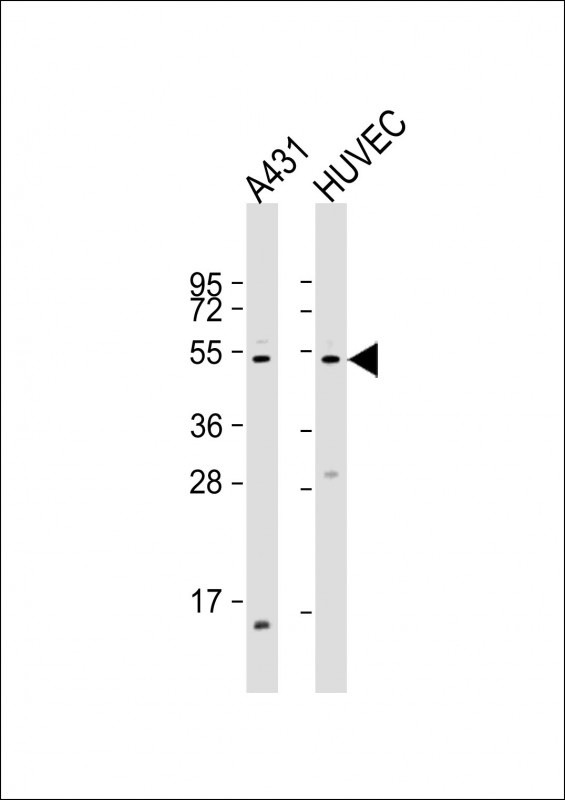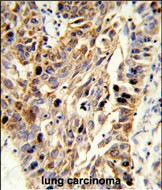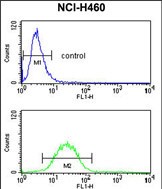EFEMP1 Antibody (N-term)
Affinity Purified Rabbit Polyclonal Antibody (Pab)
- SPECIFICATION
- CITATIONS: 5
- PROTOCOLS
- BACKGROUND

Application
| FC, IHC-P, WB, E |
|---|---|
| Primary Accession | Q12805 |
| Other Accession | O35568, Q8BPB5, Q7YQD7 |
| Reactivity | Human, Mouse |
| Predicted | Monkey, Rat |
| Host | Rabbit |
| Clonality | Polyclonal |
| Isotype | Rabbit IgG |
| Calculated MW | 54641 Da |
| Antigen Region | 119-148 aa |
| Gene ID | 2202 |
|---|---|
| Other Names | EGF-containing fibulin-like extracellular matrix protein 1, Extracellular protein S1-5, Fibrillin-like protein, Fibulin-3, FIBL-3, EFEMP1, FBLN3, FBNL |
| Target/Specificity | This EFEMP1 antibody is generated from rabbits immunized with a KLH conjugated synthetic peptide between 119-148 amino acids from the N-terminal region of human EFEMP1. |
| Dilution | FC~~1:10~50 IHC-P~~1:50~100 WB~~1:1000 E~~Use at an assay dependent concentration. |
| Format | Purified polyclonal antibody supplied in PBS with 0.09% (W/V) sodium azide. This antibody is purified through a protein A column, followed by peptide affinity purification. |
| Storage | Maintain refrigerated at 2-8°C for up to 2 weeks. For long term storage store at -20°C in small aliquots to prevent freeze-thaw cycles. |
| Precautions | EFEMP1 Antibody (N-term) is for research use only and not for use in diagnostic or therapeutic procedures. |
| Name | EFEMP1 |
|---|---|
| Synonyms | FBLN3, FBNL |
| Function | Binds EGFR, the EGF receptor, inducing EGFR autophosphorylation and the activation of downstream signaling pathways. May play a role in cell adhesion and migration. May function as a negative regulator of chondrocyte differentiation. In the olfactory epithelium, it may regulate glial cell migration, differentiation and the ability of glial cells to support neuronal neurite outgrowth. |
| Cellular Location | Secreted, extracellular space, extracellular matrix. Note=Localizes to the lamina propria underneath the olfactory epithelium {ECO:0000250|UniProtKB:O35568} |
| Tissue Location | In the eye, associated with photoreceptor outer and inner segment regions, the nerve fiber layer, outer nuclear layer and inner and outer plexiform layers of the retina |

Provided below are standard protocols that you may find useful for product applications.
Background
EFEMP1 encodes a member of the fibulin family of extracellular matrix glycoproteins. Like all members of this family, the encoded protein contains tandemly repeated epidermal growth factor-like repeats followed by a C-terminus fibulin-type domain. This gene is upregulated in malignant gliomas and may play a role in the aggressive nature of these tumors.
References
Okada,Y., et.al., Hum. Mol. Genet. (2010) In press
Wakabayashi,T., et.al., Biochem. Biophys. Res. Commun. 391 (1), 1116-1121 (2010)
If you have used an Abcepta product and would like to share how it has performed, please click on the "Submit Review" button and provide the requested information. Our staff will examine and post your review and contact you if needed.
If you have any additional inquiries please email technical services at tech@abcepta.com.














 Foundational characteristics of cancer include proliferation, angiogenesis, migration, evasion of apoptosis, and cellular immortality. Find key markers for these cellular processes and antibodies to detect them.
Foundational characteristics of cancer include proliferation, angiogenesis, migration, evasion of apoptosis, and cellular immortality. Find key markers for these cellular processes and antibodies to detect them. The SUMOplot™ Analysis Program predicts and scores sumoylation sites in your protein. SUMOylation is a post-translational modification involved in various cellular processes, such as nuclear-cytosolic transport, transcriptional regulation, apoptosis, protein stability, response to stress, and progression through the cell cycle.
The SUMOplot™ Analysis Program predicts and scores sumoylation sites in your protein. SUMOylation is a post-translational modification involved in various cellular processes, such as nuclear-cytosolic transport, transcriptional regulation, apoptosis, protein stability, response to stress, and progression through the cell cycle. The Autophagy Receptor Motif Plotter predicts and scores autophagy receptor binding sites in your protein. Identifying proteins connected to this pathway is critical to understanding the role of autophagy in physiological as well as pathological processes such as development, differentiation, neurodegenerative diseases, stress, infection, and cancer.
The Autophagy Receptor Motif Plotter predicts and scores autophagy receptor binding sites in your protein. Identifying proteins connected to this pathway is critical to understanding the role of autophagy in physiological as well as pathological processes such as development, differentiation, neurodegenerative diseases, stress, infection, and cancer.




